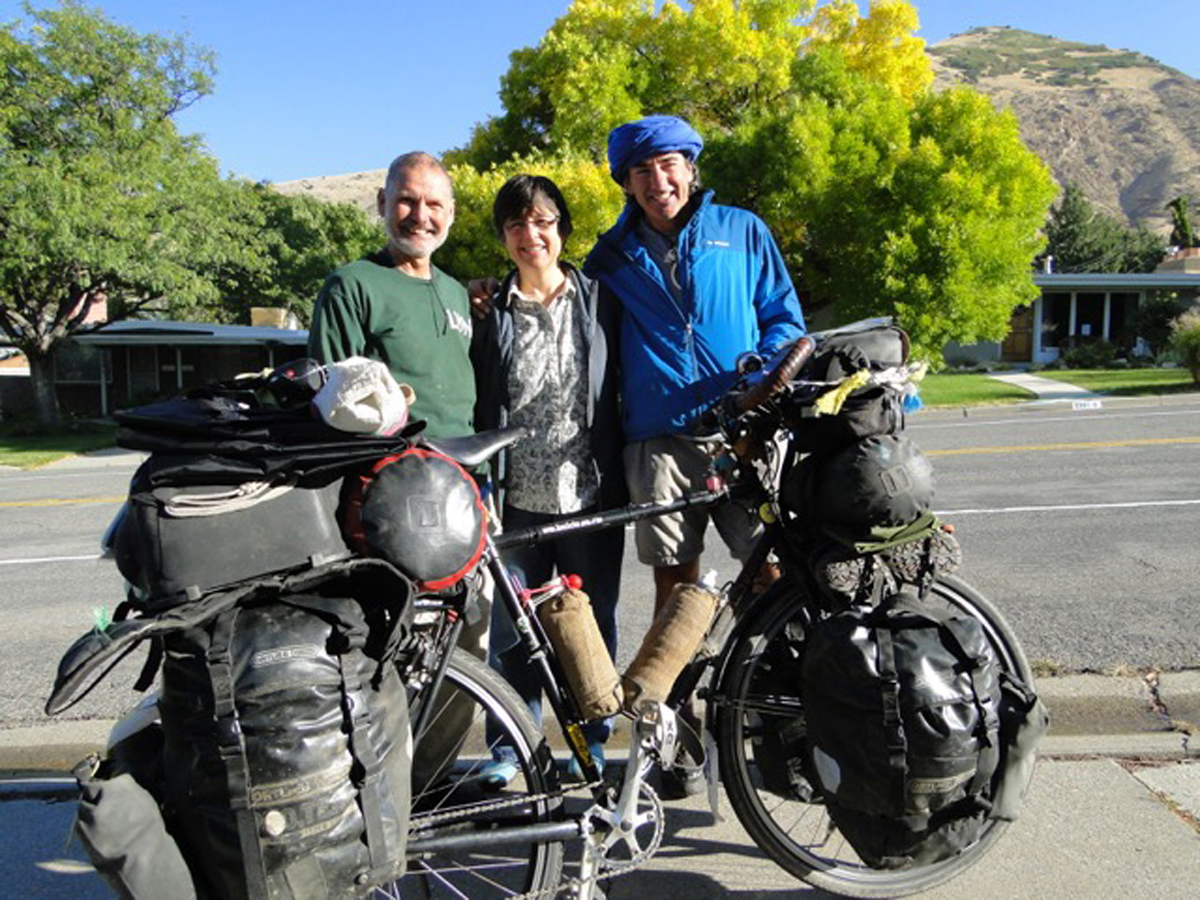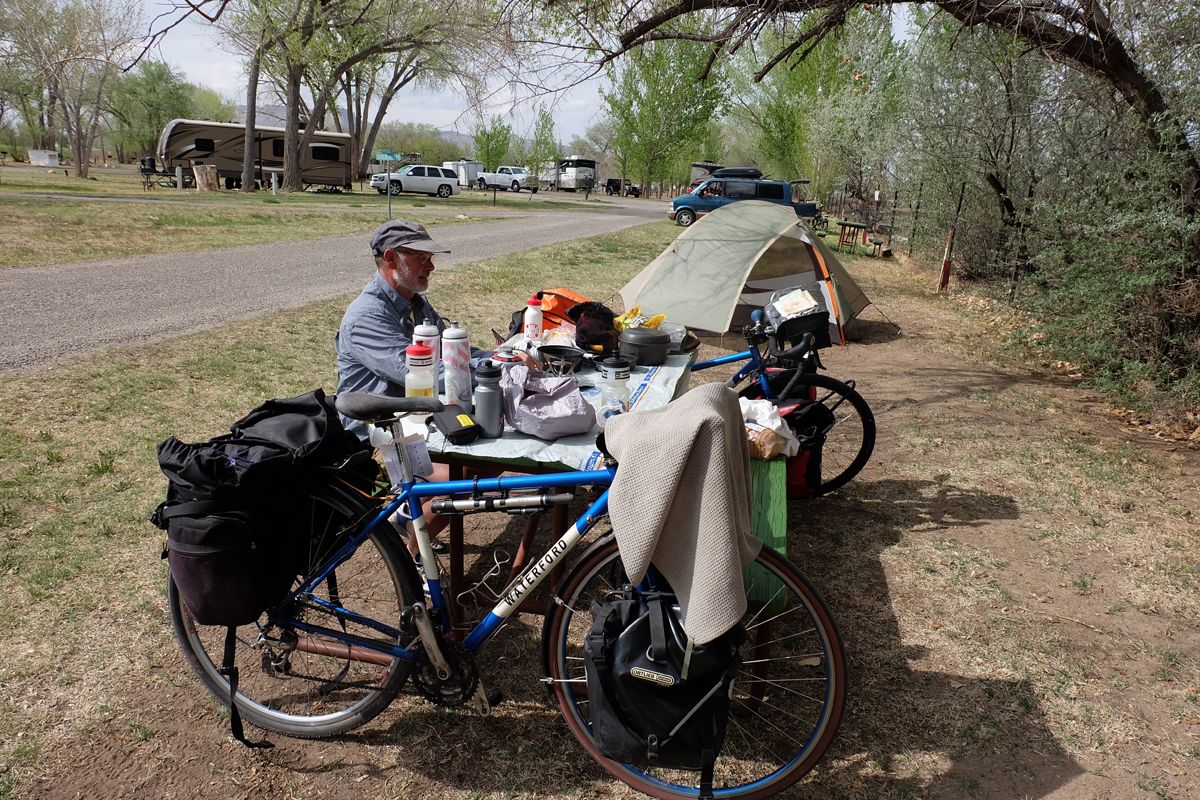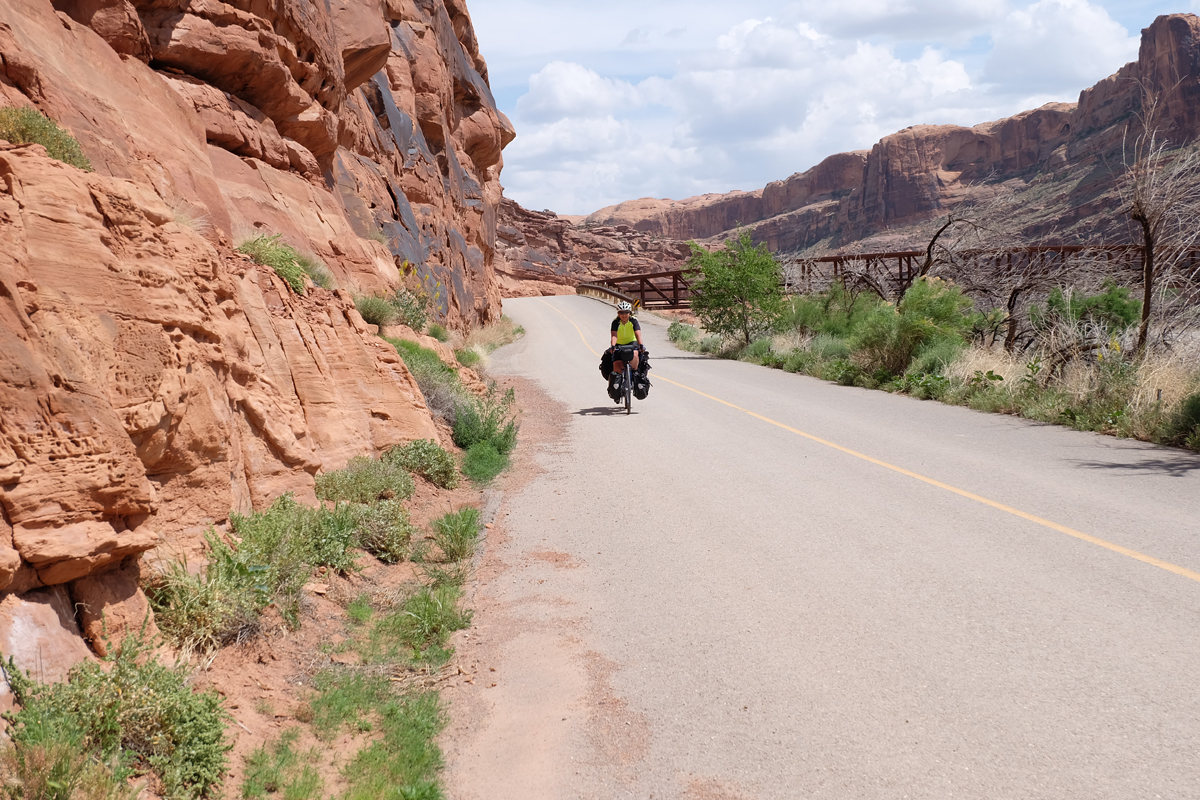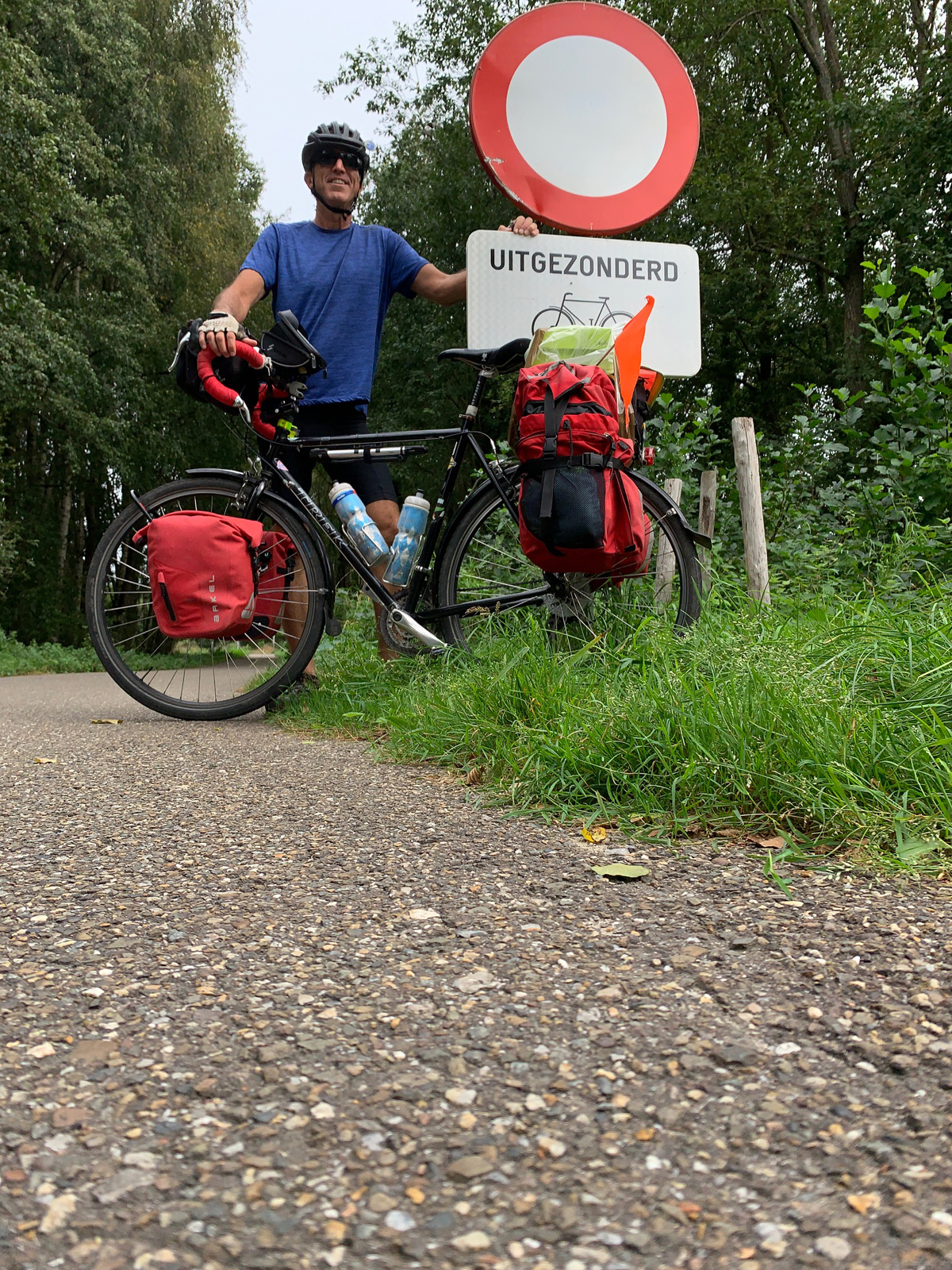By Lou Melini — Racing, commuting to work, and recreational rides have been an enjoyable part of my cycling life going back to 1971. However beginning with my 1975 ride across the United States, bicycle touring became, and still is, the pinnacle of fun on a bike. With 9 months of lifetime bike travel (plus another 9 months of backpacking that includes the Appalachian Trail) I am still a “rookie” compared to some of my friends and acquaintances. I will include the advice from Park City resident Rusty Gardner who has ridden across the U.S. 3 times, a ride on the Pacific Coast and numerous other rides including 2 with me that have totaled about 1000 miles. Rusty has also hiked the Appalachian Trail 3 times and the Pacific Crest trail once. This year I will make my second crossing of the U.S (Julie’s first) on the TransAmerica route mapped by the Adventure Cycling Association (ACA).

Planning a Tour
Available time, desired destinations, physical capability, goals and travel time to and from your desired ride are the initial decisions one needs to make to start a ride. These considerations alone could make for a book chapter. In 1975 I had no clue what I was doing nor did anyone else at that time. I quit my job as a tax auditor for the state of New Jersey, flew to Seattle with my friend Jeff and began a journey with the goal of riding back to my home. We did not know how long it would take, how far we could travel each day, nor where we would sleep each night among a host of other uncertainties. We picked up state maps at each border.

Now with Julie as my riding buddy I know how far we can travel each day and plan our distances roughly around that. I utilize ACA maps whenever possible for planning. Knowing where campgrounds, grocery stores and other amenities are located make our rides more efficient. (If you are going to Europe consider looking at EuroVelo routes.) With over 46,000 miles of mapped routes, utilizing maps from the ACA maps is a great source of information. On the other hand, I’ve spoken to a few travelers that don’t use them as “they take the adventure out of the tour”. Personally I want my tours to be vacations. I tell people that if the tour becomes an “adventure” it is due to my failure to plan and execute.
I only create a general plan of our trips, detailing our days as we travel. For example, a 16 day tour becomes 4 4-4day tours with the upcoming 4 days having more detailed planning. Julie and I ride with 4 sets of fresh bike shorts so that every 3-4 days is a “short” travel day in order to do laundry, check and clean the bikes, rest our legs, and whatever else is needed or desired.
All that Weight
There are plenty of cyclists terrified by “carrying all of that weight”, a fear I have heard multiple times. It isn’t that bad. One can ride with a loaded touring bike 60-80% of the distance compared to a recreational ride on their much lighter road bike. Go for a day ride with all of your gear to determine how far you can travel with a loaded touring bike.
Different Types of Tours
An overnight bike tour is another way to experience touring. There are many ways to do a tour, and each person should determine which way suits him, her or we. Some like Julie and I primarily camp, cook our own food and are fully self-sufficient. Others may do a “credit card” tour, staying in motels and eating out. Commercial tours are another way to travel — though other than the ACA, few offer camping and reasonably priced options. The ACA offers self-contained group tours.

What to Bring
What one takes on a tour and how far one travels is another COMPLETELY personal decision. Ride YOUR ride; make it a fun and a memorable experience. A friend of mine, Alvaro Neil de Guzman of Spain (AKA Biciclown), traveled for 14 years pedaling with 150 pounds including the weight of his bike in order to bring comfort to his travels along with cameras and computers and other equipment to make documentaries. Julie and I carry more stuff than most bike travelers. Julie and I usually average 60-70 mile days, sleeping comfortably in a 3-person tent, sitting comfortably in our folding camp chairs, and eating well with our kitchen set up that includes a tablecloth and plastic placemats for those sometimes not-so-clean picnic tables. We have varied our tours. On one 9-day Southern Utah trip we averaged a rather pedestrian 35 miles/day so that we could include about 35 miles of hiking during our trip. It was a great tour.
Traveling to the Start of Your Tour
Probably one of my biggest causes of angst preceding a trip is getting to and from the start of a tour. I fortunately love touring in the west so the proximity of our destinations has made transportation easier. Leaving our car with friends a couple of times, utilizing the empty parking lot of a ski resort in Idaho, ride the Salt Lake Express bus to begin a tour, and in Garfield County we parked our car, with permission, in the spot reserved for the ranking sheriff. Flying with bikes is expensive as our Germany trip proved, but one can avoid the airline fee with folding bikes or using S & S couplers. Acquaintances of ours have shipped bikes in the U.S. to and from bike shops close to the airport that they were flying into and out of. Other friends have used one-way car rentals or getting to a touring destination by shuttling cars for car rental agencies.

Where to Sleep
Where to sleep is the second concerning item on my list. Again, utilizing the ACA maps help immensely. When we are off the ACA grid, we’ve had a few discussions about where we would stealth camp, a rare occurrence. The only time we made advanced reservations was an anticipated arrival in Mt. Rainier National Park on the 4th of July. We’ve only been turned away from one private campground, though we have had to “negotiate” a few times. There are now many campgrounds that “don’t do tents”. On two occasions at Lake Louise campground in Banff National Park we were waved to the front of the line and accommodated despite the “campground full” sign. Hiker/Biker sites are always welcoming in many state and national parks and some states (not Utah) have a no turn-away policy for state parks. If you are only utilizing motels, reservations may at times be necessary, as one does not know if there is a soccer tournament in town. I have done a few tours with groups, and found that reservations are good in this situation (more than 2 tents or more than 4 people). As a former member of the Board of Directors I can attest that Warmshowers, an international organization that can provide a place to sleep for touring cyclists, is a great way to obtain housing. But please, be polite, thankful, donate and become a host as well as a guest.
Traveling Companions
Despite occasional condescending remarks that I “drag Julie on bike tours”, I will proclaim that I am very fortunate that I have a spouse that loves to travel on her bike with me. I would be doing a lot less bike travel if she didn’t like to come along. I prefer to not travel alone. However, for most of the guests Julie and I have had at our house, traveling alone is the preferred method. Traveling alone gives one complete freedom to make all the decisions in a trip. On the other hand, one camps alone and loses some face-to-face social contact which is the part of traveling alone I don’t like. Our Warmshowers hosting has provided welcome social contact for many cyclists from around the world; a few of which we have kept in touch with for many years.

Problems may arise when traveling (bike touring or backpacking) with another person or with a larger group due to the unique physical and psychological stresses that occur during a long trip. A long stretch of rainy weather can dampen personalities, no pun intended. Small differences in travel styles such as lodging (camping vs. motels), eating (dining out vs. eating in camp), money issues, getting out on the road late in the morning, riding late into the evening or having a negative attitude can end relationships during a trip. In the days long before cell phones (~1980) I had a guy ride off on the 2nd day of an Oregon coast tour, never to be seen again during the trip. He had the tent poles of the tent that he shared with one of the remaining riders! The good news is that on my trips with others I have acquired lifetime friendships and great follow-up conversations.
The Bike
I have seen a large variety of bikes used for touring in my lifetime of touring including bikes that are normally seen in a racing peloton. In 1975 I used a bike from Sears to cross the country. Now Julie and I have matching custom made Waterford built in Julie’s home state of Wisconsin. Touring bikes from Co-Motion are another popular American brand. In the 1980’s and 90’s Trek 520’s were the number one touring bike but today I would say that the Long Haul Trucker by Surly is the best selling tour bike. Soma and Rivendell also have nice touring models. In general, any bike with a rack or the ability to fit the new bike packing bags will due. Rusty and I both agree that a bike built for touring is best and to be sure that it is in great mechanical condition before the tour. The general description of a good touring bike is that it rides better with weight and I agree. I’ve had friends break spokes, chains and a derailleur on the first day of a short tour after taking their “vintage bike off the garage wall”. Discussion of parts and accessories are beyond this article.
Bike Maintenance
During my 1975 bike trip across the U.S. it seemed that some bike parts were meant to fail. Even the patches to fix a flat were terrible. Today one could tour for 10,000 miles and only need to replace tires, chain, and brake and derailleur cables and housing. Bike parts are good. Even lower priced Shimano parts are better than the stuff I rode with in the ‘70’s. I had no mechanical experience before my cross- country ride. Don’t make that mistake. For a longish tour you should be comfortable fixing flats, repairing a chain and trouble shooting minor mechanical problems. I’ve had two different Warmshowers guests that had ridden from Denver with a brake pad rubbing on a wheel rim as they were unable to fix the problem. (They were appreciative of the 5-minute fix.). I’ve lent out front racks to 2 riders including one that rode up my driveway with a front rack that had bent in a 90-degree angle. In 10,000 miles of travels with Julie, I’ve had to twice adjust her rear wheel spokes, fix a chain once and on one occasion troubleshoot a front derailleur that lost a pivot pin. We’ve only had a few flats. Perhaps the worst problem occurred when my bike fell over partially dislodging the brake lever from the housing. Fortunately I had a brake lever at the time that allowed me to work the lever back in place without completely destroying it. In this era, you can always FedEx parts, tools and whatever to your location. I still laugh about my friend Daisuke from Japan (11 years of travel) cursing at a chain he purchased in India; “s**t chain; s**t chain”. The new chain broke within 50 kilometers after putting it on his bike. (I was surprised he didn’t carry a spare chain and tool in that part of the world). A bike shop from Israel shipped him a chain and tool as a follow up to his email rant!
Extras to Bring
Riding over 350 miles/week for weeks on end is physically and mentally tiring. I bike travel a bit heavier vs. backpacking. A 3-person tent adds plenty of room for the added weight along with a thicker sleeping pad. A tablecloth adds to the campground cleanliness. Plastic placemats that double as cutting boards allow me to set a sandwich down on a clean surface no matter where I am, a 2-ounce addition that some of my long distance travelers have copied. My kitchen is adequate for many great meals. I carry a water filter in southern Utah and (occasionally) bear spray in bear country. I am able to tighten every bolt on my bike, have a chain tool, and extensive patch kit and spare tubes. I’ve used my spare tire on 2 occasions due to bad cuts. And of course there are the books to end the day.
Conclusion
I will end the “Cliff Notes” version of bicycle travel. The best lesson to learn about how to travel on your bike is simply to go out on your bike and do it. You will be surprised to find that after about a total of 2 weeks of bike travel experience you will gain enough confidence to keep going. If you still need more information about bike touring go online and Google bicycle touring. For your first tour consider an early spring or fall tour to the National Parks of Utah, a Yellowstone tour, or the off-road Idaho mountain bike hot springs tour. I’ve done all 3 and enjoyed each one for different reasons. Enjoy your ride.
Editor’s Note: Cyclingutah.com and past issues of Cycling Utah / Cycling West have plenty of touring stories, overnight tours, long tours, tips, and suggestions.








I always bring a plastic tent peg hammer. The other cyclists have laughed at me but many times they’ve ended up asking to borrow it to drive their pegs into hard ground.
Jeff. Thanks for the reply. I did a tour with a person that brought along a plastic tent peg hammer. It became a popular item in some of the campgrounds. My article was originally published about 10 years ago but has a 2023 publishing date. As a result the article is a bit dated so suggesting that including a tent peg hammer is not out of the question in an update. I can usually find a rock but bending a tent stake is a risk with a rock.
Comments are closed.